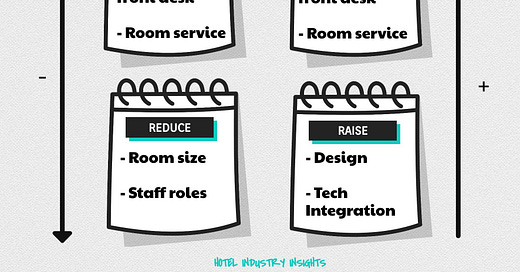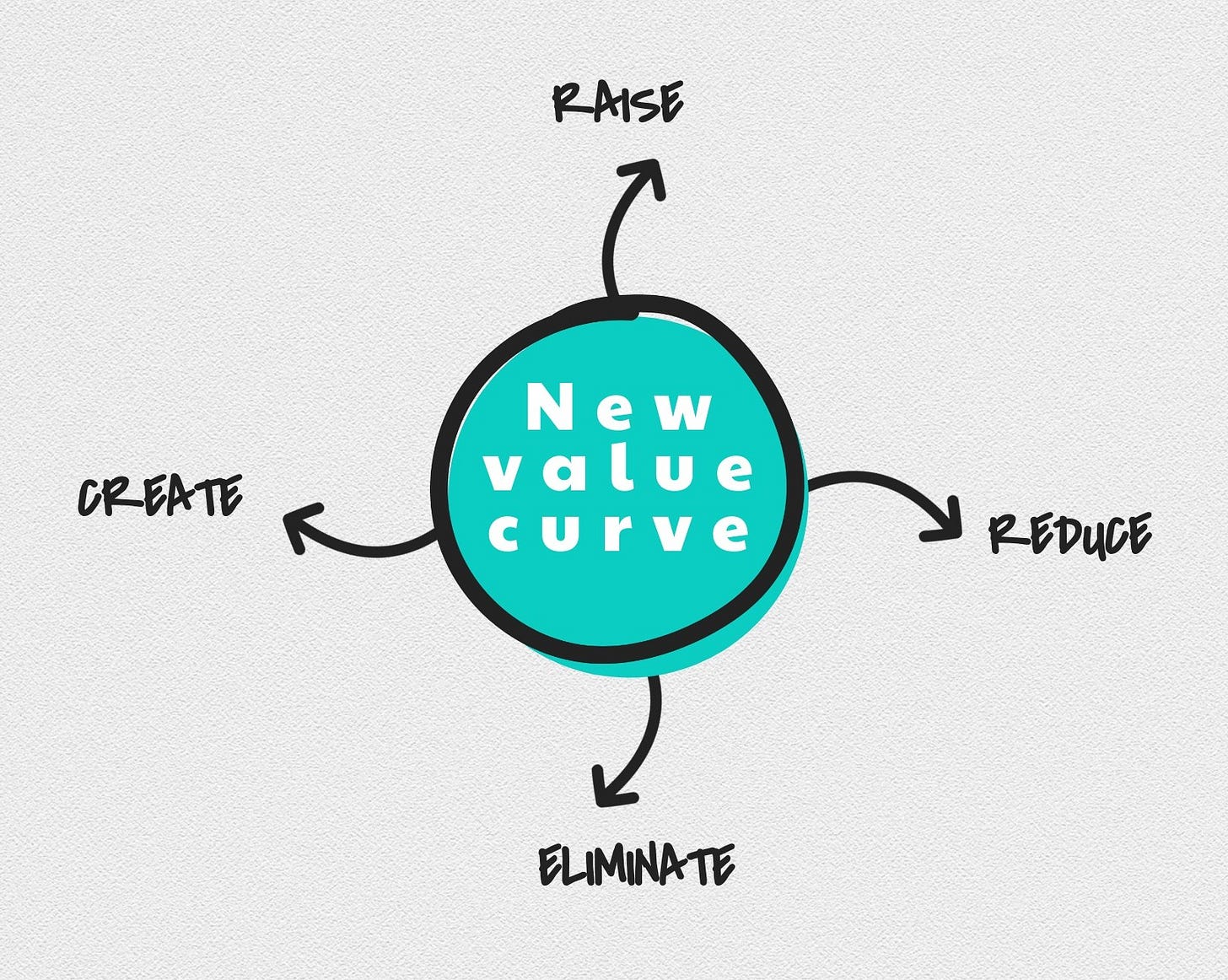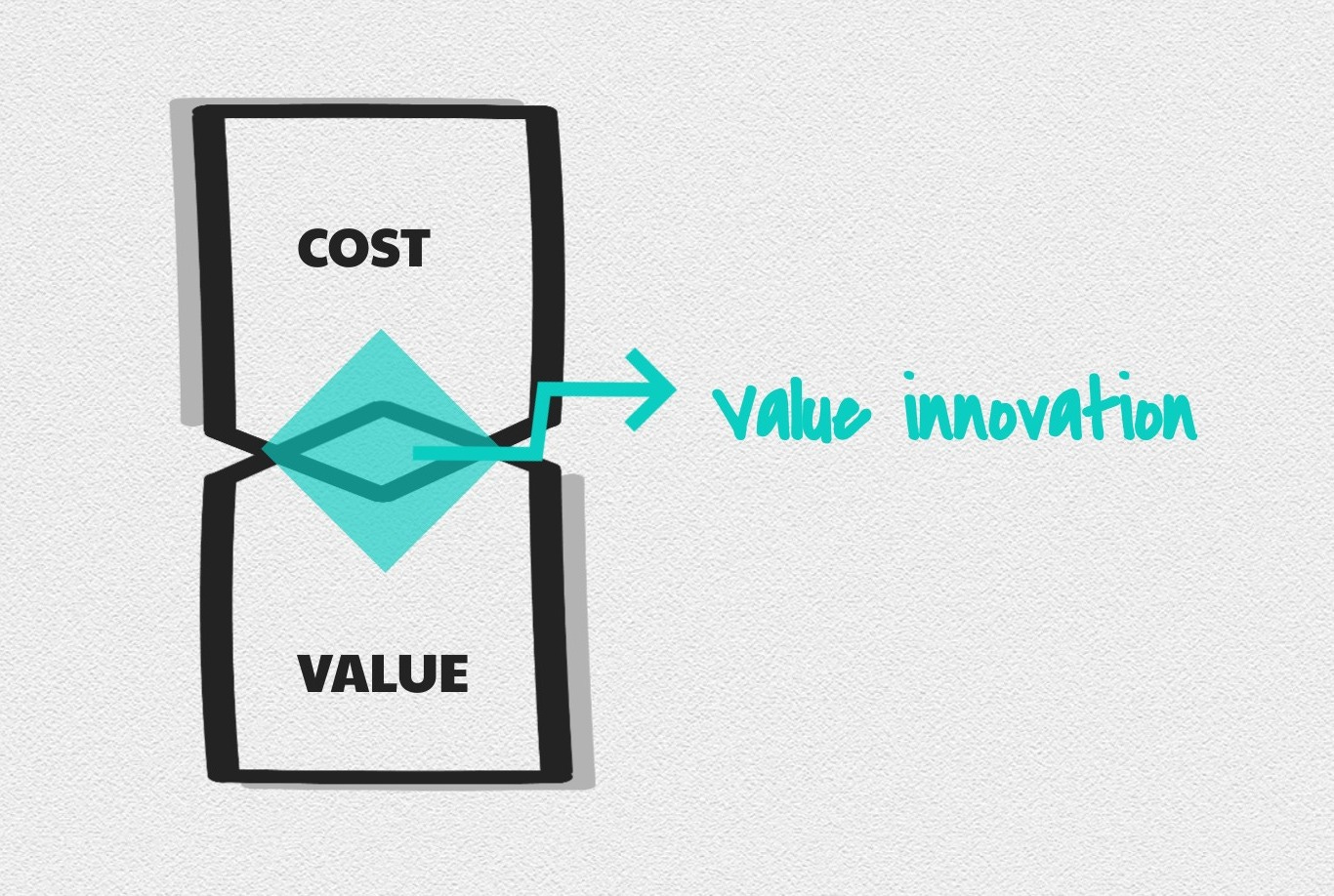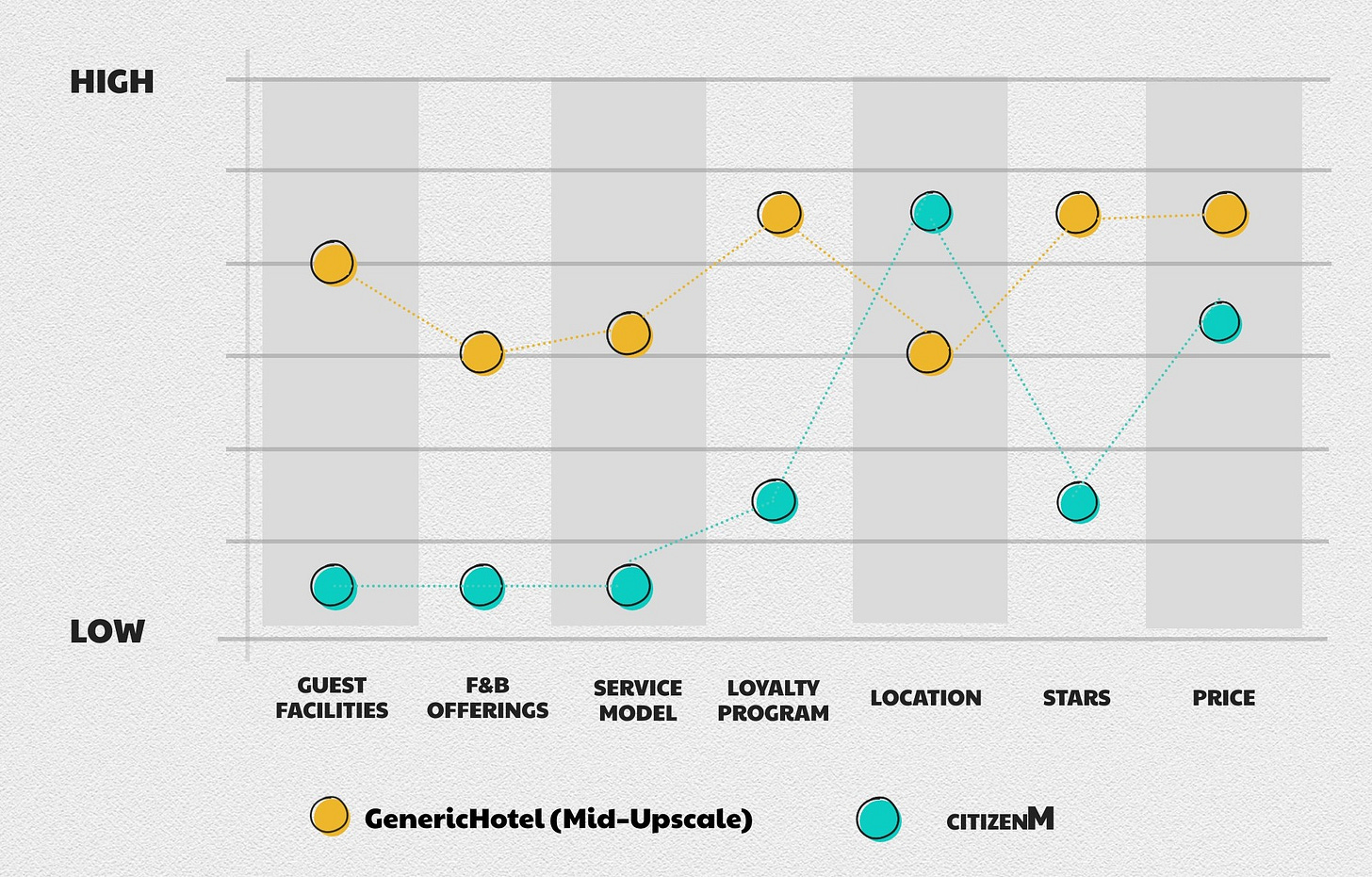Hotel Innovation: The value-curve approach to redefine hospitality and outshine competitors
Redefining Hotel differentiation in a saturated market
This is a continuation of Part I—if you haven’t read it yet, I recommend checking it out first! A huge thanks to everyone who read, shared, and supported Part I—We truly appreciate it.
In a hyper-competitive hospitality arena defined by ever-shifting consumer demands, OTA-driven booking funnels, and escalating costs, hoteliers face a crucial dilemma: how can you safeguard the timeless warmth of hosting while harnessing advanced technology for modern travelers?
That’s where value-curve thinking comes in, inspired by the Blue Ocean Strategy framework by W. Chan Kim and Renée Mauborgne. This approach invites hoteliers to break free from industry norms by reducing or eliminating outdated elements, while elevating or introducing features that resonate with today’s travelers. The goal? To craft a distinct guest experience that’s not just competitive—but category-defining.
In this article, I’ll explore how any property—whether it’s part of a global chain or a cozy, family-run boutique—can use the Reduce–Eliminate–Raise–Create (RERC) model to refresh its guest offerings. We’ll break down the theory behind the framework, look at how trends in the hotel sector are evolving, and share a case study. Finally, we’ll lay out some concrete steps you can take to avoid the race to the bottom and carve out your own space instead.
The value-curve concept and the four actions framework
At the heart of Blue Ocean Strategy is the notion of creating uncontested market space by focusing on buyer value in a new way. The “value curve” is a visual tool that plots your brand’s performance across key industry factors, enabling you to see how you line up against competitors.
Most hotels' curves look similar—everyone invests heavily in certain amenities (like front-desk staff, upgraded bedding, 24/7 room service, etc.), with minor variations. True disruption arises when you systematically choose which factors to:
Eliminate: Which long-standing features or services are taken for granted but add little real guest value?
Reduce: Which elements are overserved or can be scaled back without harming the core experience?
Raise: Which aspects are under-served, or represent an opportunity to exceed standard expectations?
Create: What new experiences or services can you introduce that the market has never seen?
By performing these four actions, you shift your cost structure (saving money by eliminating or reducing certain things) and reallocate resources to fresh, high-value aspects. Let’s see how that works in the real world.
4. Case Study: CitizenM
One brand that systematically used a “value-curve” mindset to stand out is CitizenM. Launched in 2008, CitizenM set out to disrupt the midscale-to-upscale segment by targeting modern travelers who want a stylish experience with minimal fuss. Instead of chasing a conventional star rating or replicating typical “luxury,” they reimagined which services truly mattered to a tech-savvy, design-conscious audience. Let’s see how they used Eliminate–Reduce–Raise–Create to reshape the competitive field.
4.1 Eliminate
Traditional front desk: CitizenM removed the typical check-in desk where staff greet guests. Instead, they intoduced self-check-in kiosks. This bold elimination was a gamble—front-desk interaction is often seen as crucial—but CitizenM believed their target traveler valued speed and autonmy more than a desk clerk’s chat.
Room service: They cut expensive room service entirely, redirecting resources to an upgraded communal area (a canteen concept open 24/7). This elimination saves staff costs, reduces complexities, and fits modern travelers used to grabbing quick bites or ordering from an app.
4.2 Reduce
Room size: CitizenM’s rooms are notably smaller than typical four-star accommodations. They reasoned that many travelers (especially younger, busy ones) don’t spend much time in the room beyond sleeping and showering. By reducing room size, they reinvested in higher-quality bedding and high-tech room features (like mood lighting, integrated tablets, etc.).
Staff roles: Instead of having a doorman, bellhop, front desk, and separate lounge attendants, CitizenM introduced multi-skilled “ambassadors” who can handle a variety of tasks. This reduced specialized roles but kept an energetic staff presence available to handle guest needs on the spot.
4.3 Raise
Design and aesthetics: CitizenM spent far more on stylish interiors, curated art, and an eye-catching lobby/lounge. They raised the bar on design so that even though rooms were smaller, the overall vibe felt upscale and cool.
Tech integration: From self-check-in kiosks to in-room tablets that control lighting and entertainment, they raised the technology aspect beyond what was standard for midscale hotels. This emphasis appealed to travelers who wanted a frictionless digital experience.
4.4 Create
Living room-style lobby: Instead of a standard reception or lounge, CitizenM invented a “living room” concept—cozy nooks, communal tables, a 24-hour canteen. It was a new kind of common area that fosters social interaction. Their logic was that modern travelers appreciate shared spaces more than fancy personal space (especially if they're city explorers).
Artistic and rather youthful) brand image: They created a brand identity that resonates with younger travelers who want something “cool” but not pretentious. Everything from marketing campaigns to in-room signage exudes a playful, edgy voice that sets them apart from stiffer, more traditional chains.
5. Adapting a value-curve approach to your own Hotel
Whether you’re a family-run boutique or part of a massive chain, you can replicate elements of the CitizenM approach by systematically applying the Reduce–Eliminate–Raise–Create grid. Here’s how to start:
Brainstorm industry factors
List out all the traditional “factors” in your segment—like front-desk staff, in-room amenities, dining style, loyalty perks, star rating, location-based marketing, etc. Involve staff from various departments to ensure no stone is unturned.Plot the competition
Identify the standard or “expected” levels of these factors. For example, a 4-star property might have 24/7 room service, mid-tier pricing, a loyalty program, etc. Plot them on a rudimentary chart, seeing how your hotel compares.Ask the four questions
Eliminate: Are you paying for an underused amenity or service that guests no longer truly value? Perhaps that rarely used business center or that extravagant nightly turndown, which might not matter to your target segment?
Reduce: Are you overserving certain aspects? Maybe you have too many staff roles that could be consolidated or an overly broad F&B menu that leads to waste.
Raise: Which elements are you currently doing at a minimal or “me too” level that you could supercharge? Maybe doubling down on distinctive local experiences or robust in-room technology.
Create: Are there experiences or offerings that don’t exist in your segment? Maybe a community-focused lounge, a digital VIP pass, or a sustainability-oriented program that resonates with eco-conscious guests.
Test small, scale fast
Innovation can be risky, so consider prototyping changes in a single property or even a single department. If you’re removing room service, perhaps try it at one location first. If you see positive response—like cost savings with no drop in satisfaction—roll it out chain-wide.Market your differences
No matter what you do, you must clearly communicate the “whys” to your guests. If you’ve eliminated something they might expect—like a formal front desk—explain how it frees them from waiting in lines. If you’ve added something new, highlight that in the pre-stay email or brand story.
Next week part III
🏨 Interesting reads
Iconic Luxury Hotels to open Gran Marbella Resort and Beach Club
Cvent's MICE sourcing volume reached record levels up 75% from pre-pandemic volume, driven by demand for tech and AI solutions.
Mandarin Oriental reports an 8% decline in FY2024 profits due to higher operating costs despite 7% RevPAR growth.
Wyndham launches the first US debit card for travelers.
Inn-Flow secures $45M to expand its AI-driven hotel accounting platform.
TFE Hotels says it’s still recovering from a major cyber incident.
📅 EVENTS
SAHIC Hotel & Tourism Investment Forum. Mar 24 – 25, 2025
Fairmont Rio de Janeiro Copacabana20th Annual Executive Vendor Summit. Mar 26 – 28, 2025
The Seelbach Hilton LouisvilleHotelex Shanghai. Mar 30 – Apr 2, 2025. National Exhib.&Conv Ctr (Shanghai)
2025 Meetings & events outlook: Key trends hoteliers must leverage. Thu, Mar 27, 2025 – 4:00 PM
Automation that enables personalisation: Secrets from hoteliers. Thu, Mar 27, 2025 – 2:00 PM
💸 Special deals for hospitality professionals
Price Seeker: “Limited time offer: Enjoy 3 months free on our advanced price intelligence platform”
Cloudbeds: “Sign up for a demo and receive $250 of free credit”
Mara: AI review response generator. Try it out for free!
If you're interested in adding your special offer to a list of hospitality deals, you can reach out to hotelindustryinsights@gmail.com.
💡CREATIVE ADS
💡 Stay ahead of the curve with the latest industry insights! Subscribe to: This Week in Hospitality for a weekly roundup of the most important events shaping the hospitality world.
🌍 For exclusive updates on high-end experiences and luxury travel trends, subscribe to Luxury Travel and never miss a beat in the world of premium hospitality.
🙏 Thanks for reading Hotel Industry Insights!
Join 9,988 hoteliers already transforming their businesses with innovative, practical strategies.
💡 Found this edition valuable? Show some love by hitting the ❤️ and sharing it with colleagues, friends, or on social media!
Want to showcase your company to 10,000+ hospitality decision-makers? Learn more here.









Interesting. Thnaks for sharing